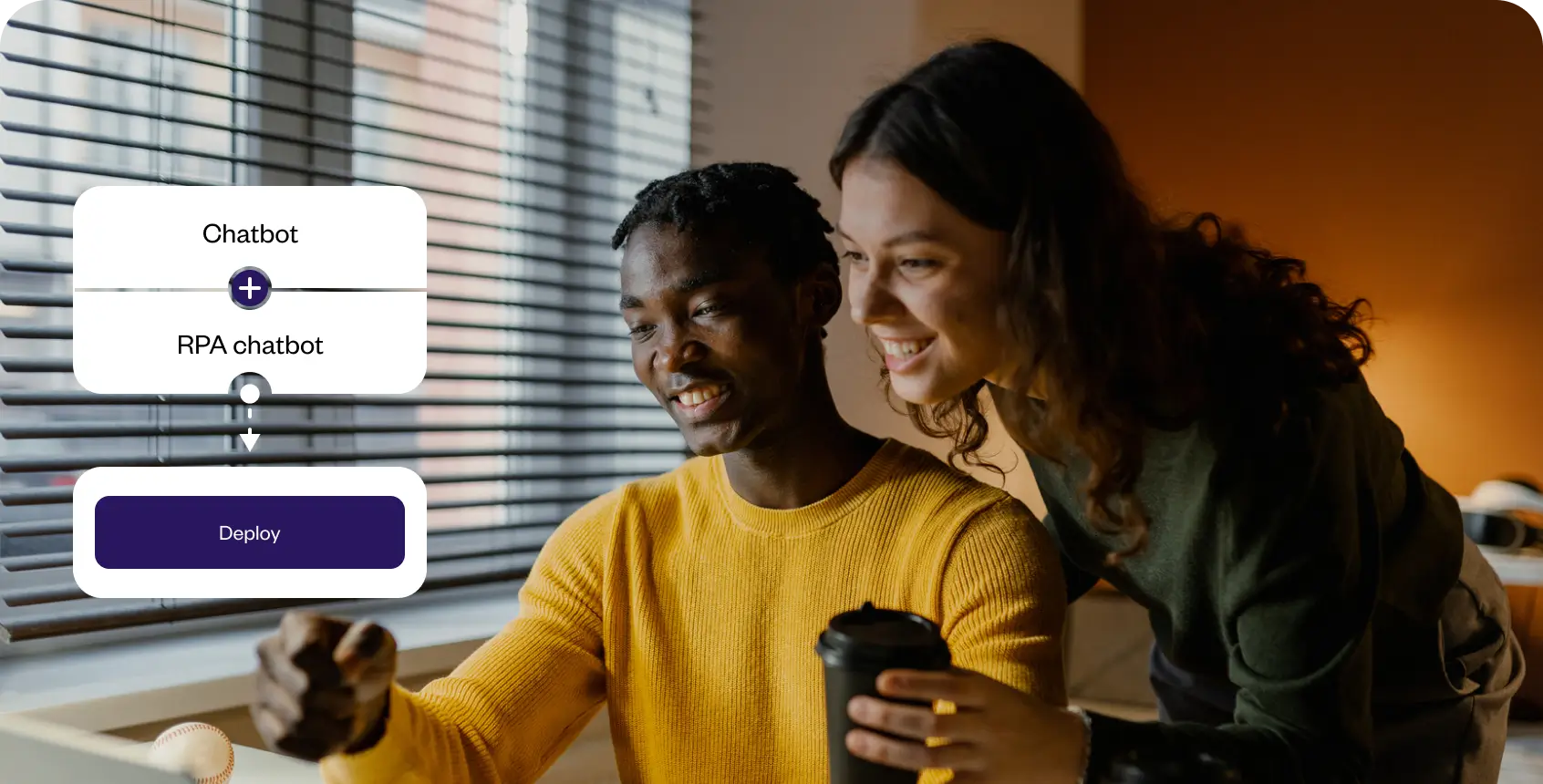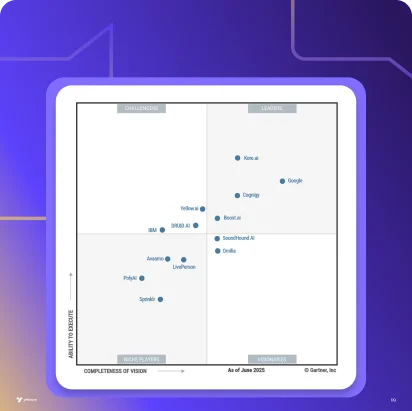We have entered into a new era of hyper-automation where humans and machines will increasingly work hand-in-hand. Some of you might already be aware of the popularity of Chatbots and RPA in the automation ecosystem for enterprises. However, the bigger question is, what would happen if we integrate these two robust technologies?
In this article, we will explore how the intersection of RPA and conversational AI can increase business efficiency and how Yellow.ai is helping enterprises attenuate business problems by replacing rule-based models with advanced cognitive models.
What is Robotic Process Automation (RPA)?
Robotic Process Automation, or RPA for short, is like your behind-the-scenes ninja in an organization. At its core, RPA is software that automates rule-based tasks that were traditionally performed by a human interacting with digital systems. Think of it as creating a virtual workforce that can handle repetitive and mundane tasks—like data entry, invoice processing, or even email sorting—with incredible speed and precision.
Now, why does that matter to you as a business leader? Because time is money. With RPA, you’re not just saving a few minutes here and there; you’re transforming entire workflows. It allows your human talent to focus on more complex, creative tasks that add real value to your customer experience and business operations. So, in essence, RPA is like an efficiency booster shot for your organization, freeing up time and resources to tackle bigger and better challenges.
Difference between RPA and chatbots
While they both RPA and chatbots aim to make life easier—whether it’s for your customers or your employees—they serve different masters and specialize in different tricks. Here’s how they’re different, in plain English:
1. Underlying principle
Chatbots are like your company’s digital front-of-house staff. They use Natural Language Processing (NLP) to interact with humans in a way that feels, well, human. They’re smart enough to deal with unstructured input, like your customer asking, “How do I reset my password?” in a million different ways. Chatbots can interpret this and offer an appropriate solution.
RPA, on the other hand, is your back-office powerhouse that loves structured, rule-based tasks. It’s like having an extra set of hands that never gets tired. While RPA can integrate with AI and machine learning tools for more nuanced decision-making, its bread and butter is following a strict set of rules to get tasks done—efficiently and without complaint.
2. Task suitability
Chatbots shine when there’s a need for interaction with customers. They can answer questions, guide users through processes, and even troubleshoot problems—all in real-time. Imagine a chatbot as your company’s ever-alert customer service rep, but one that never needs a coffee break.
RPA is your go-to for tasks that are more monotonous and well-defined. We’re talking data entry, invoice processing, and other repetitive tasks that are crucial but don’t necessarily require human creativity or decision-making. It’s your behind-the-scenes maestro, making sure the orchestra of your business processes plays in tune and on time.
3. User engagement
Chatbots are designed to chat; it’s in the name. They’re interactive by nature and aim to offer a user experience that feels as natural and helpful as talking to a well-informed human. They understand nuances in language and context, and they’re always ready to assist.
RPA, however, is like your silent partner in crime. It works invisibly in the background, interacting not with your customers but with your existing software applications. It’s performing tasks that help your business run smoothly, although your customers may never know it’s there.
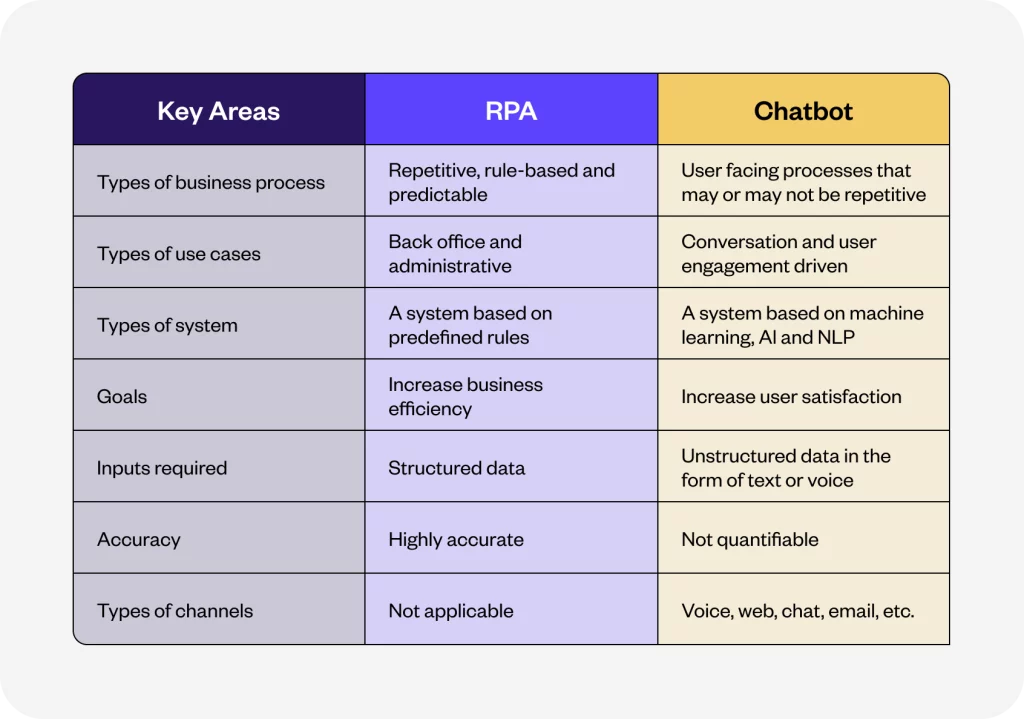
RPA and chatbot integration
In a generic scenario, a chatbot interacts with a user, identifies their intent, and helps them complete the intended user journey. From a use-case perspective, a chatbot often integrates with systems like CRM and HRMS to fetch and store relevant information about the user. Often, these systems might not support APIs, which is where RPA plays a critical role.
Robotic Process Automation (RPA) can seamlessly integrate with chatbots and help the chatbot to complete a business process, access, or store information with legacy systems that do not have APIs. We have integrated with Robotic Process Automation (RPA) providers like UiPath, Automation Anywhere, etc seamlessly through APIs and other means as per the use-case.
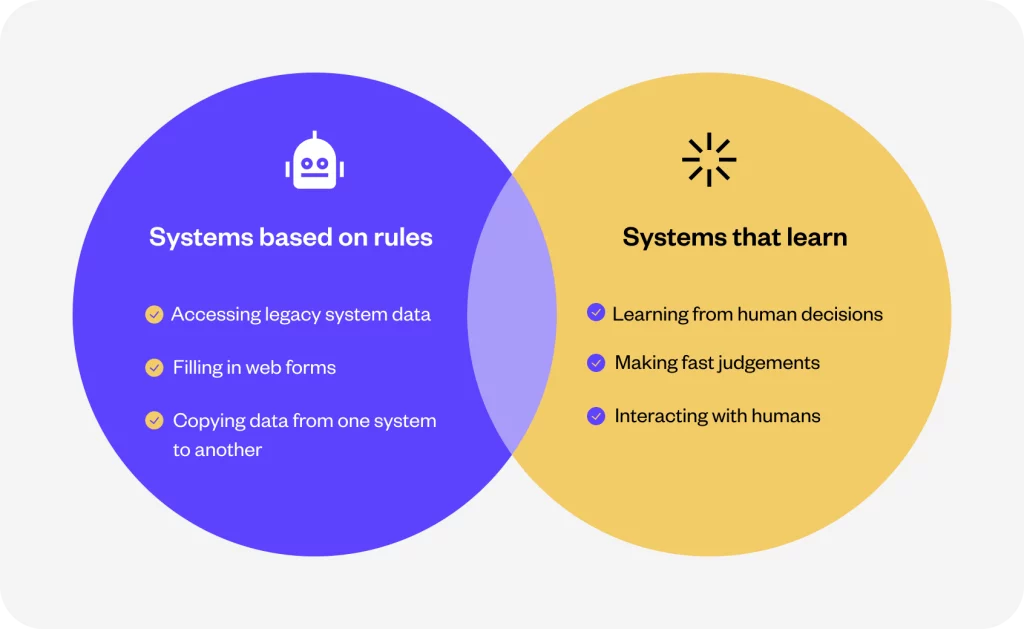
Case study – Integration of Yellow.ai chatbot with UiPath RESTful API
Our journey begins with an integration we’re particularly proud of: Yellow.ai’s chatbot smoothly cooperating with UiPath through its Orchestrator’s RESTful APIs. In practice, the chatbot collects user data as needed, sifts it through our cloud-based platform for intricate journeys, and forwards it to a designated queue via precise API calls.
1. The nuts and bolts: Data flow and API interactions
Once the RPA routine wraps up, an API call sends a payload to our messaging API. This payload holds data that either needs to be processed within our platform or reflected back to the chatbot. In essence, this creates a bi-directional data flow, enabling the chatbot to work in harmony with RPA bots and processes.
2. Solving the user retention puzzle
Here’s where things get interesting. Enterprises often struggle with retaining users during RPA processes, leading to longer resolution times and subpar user experiences. Our intelligent chatbots, integrated seamlessly, alleviate such pain points—no more fretting about user drop-offs or sluggish resolutions.
3. Pre-built for quick deployment
Yellow.ai isn’t just about chatbots; it’s a complete ecosystem. Our pre-built integrations with tools like CRM, ERP, and HCM mean you can get up and running without breaking a sweat.
4. The bot orchestrator: A maestro in disguise
In more complex scenarios requiring multiple ‘child’ chatbots, our bot orchestrator steps in. It’s not just a conductor; it’s a maestro. The orchestrator employs a recommendation engine to serve up the most relevant responses, coordinating between the most appropriate bots across a variety of channels and languages.
5. Training vs learning: A semantic approach
Traditional RPA demands a guided, step-by-step training process. In contrast, our chatbot operates on a semantic model that’s easily fine-tuned with the right vocabulary. Thanks to robust machine learning and NLP models, our chatbot not only learns but provides valuable conversational insights over time.
6. Front and center: The role of Yellow.ai chatbots
To put it succinctly, our intelligent chatbots act as the face of your customer interaction. They gather, filter, and process user data while operating behind the scenes, managing the RPA workflow in the back office. All in all, it’s a harmony of automation, data, and user engagement.
How do chatbots and RPA compliment each other?
When it comes to scaling your business operations, it’s not a matter of choosing between chatbots and RPA—it’s about understanding how these two powerhouses can join forces for a one-two punch of efficiency and customer engagement. Think of it as Batman and Robin for your business processes: individually strong, but unstoppable when teamed up. Here’s how they complement each other:
1. Bridging structured and unstructured data
Here’s the deal: RPA loves structured, rule-based tasks. It’s your go-to solution for handling anything repetitive or mundane. But what about unstructured data that comes from customer conversations? This is where chatbots like those powered by Yellow.ai come in. They excel at navigating the messy, human world of unstructured dialogues, turning it into structured data that RPA can understand. Essentially, chatbots can be the trigger that sets an RPA process into motion, making for a seamless user experience.
2. Intelligence amplification
Yellow.ai’s chatbots are designed to be self-learning and contextually aware. They understand user intent, collect the necessary data, and then format it for RPA processes. Over time, this makes your automation smarter and more efficient, like a well-oiled machine that keeps getting better.
3. Real-time synergy
Imagine a customer asking a chatbot about loan approval status. The chatbot can instantly trigger an RPA process to pull real-time data, allowing for immediate, accurate responses. It’s like having a super-efficient customer service team that works around the clock, but without the overheads. The two-way communication enabled by this pairing ensures that information flows smoothly, quickly, and accurately.
4. Elevating user experience
Let’s be honest, nobody likes filling out long forms or surveys and then waiting around for responses. That’s so last decade. Instead, chatbots engage users in natural conversation, collecting necessary information in a way that doesn’t feel like an interrogation. They get the ball rolling, and RPA picks it up to sprint towards the finish line. It’s quicker, it’s easier, and it feels a whole lot more human.
In essence, chatbots and RPA together make for an automation dream team. Chatbots serve as the intuitive, front-facing interface that interacts with your users, while RPA takes care of the heavy lifting in the background. The result? A customer journey that’s not only efficient but also delightfully engaging.
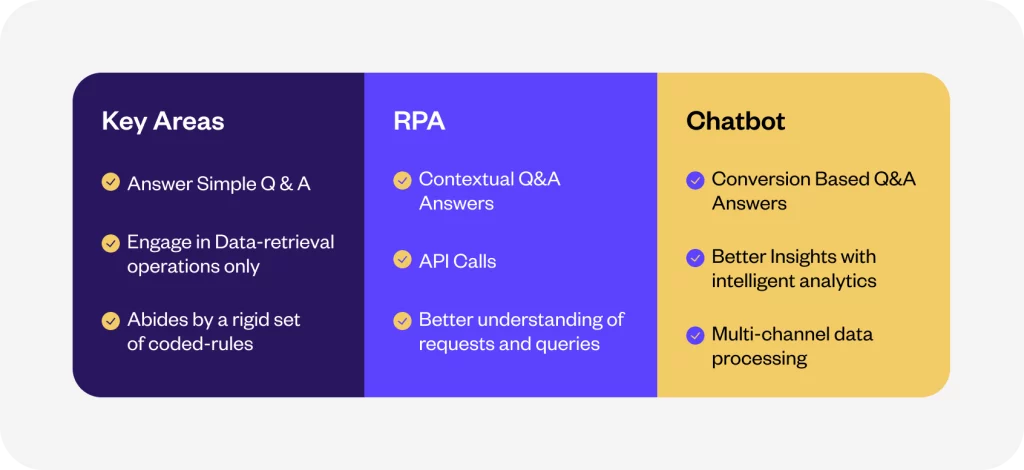
RPA and chatbot integration use cases
Let’s get down to the brass tracks of how combining RPA and chatbots can transform mundane operations into streamlined efficiencies, shall we? Spoiler alert: It’s not just about slapping a chat interface on top of your existing systems and calling it a day. It’s about capturing and leveraging data—data that’s been slipping through the cracks of your processes until now. With Yellow.ai, we’re talking about tapping into actionable insights like user sentiment, intent, and even frequency of engagement. Trust me, the data pool gets richer the more you dive in.
1. Streamlining insurance claims
Imagine someone’s had a fender-bender. They’re frazzled, and the last thing they want is to jump through hoops to file an insurance claim. Enter your savvy chatbot, equipped to gather all the preliminary details. But here’s the kicker: once the bot’s done its part, RPA kicks in to sift through the backend, pulling up customer policy details, validating information, and even flagging any issues that require human intervention. It’s a seamless handover, giving your customer a smoother, faster claims process.
2. Elevating customer service to an art form
Nobody likes to be kept on hold listening to Muzak. They want answers, and they want them now. A chatbot serves as the first point of contact, understanding the customer’s needs in a jiffy. From there, RPA swoops in, fetching real-time data from various systems to provide the chatbot with everything it needs for a tailored response. The result? A customer who feels heard, understood, and served—all in record time.
3. The HR assistant you didn’t know you needed
Think of your HR department as a high-performance car; it can’t run at its best if it’s bogged down with routine queries and tasks. RPA can automate these chores, while a chatbot serves as the user-friendly interface for your employees. Whether it’s explaining leave policies or navigating through health benefits, the chatbot gathers the initial query, and RPA retrieves the required information. Now, your HR team can finally focus on what really matters: fostering a vibrant workplace culture and driving employee engagement.
In the end, it’s not just about automation; it’s about intelligent automation. Your chatbot engages with your audience, understanding their needs, while RPA works tirelessly in the background to make those needs a reality. It’s the dynamic duo you didn’t know you needed, making both your customers and your bottom line happier than ever.
RPA and chatbot integration FAQs
Do chatbots use RPA?
No, chatbots and Robotic Process Automation (RPA) are distinct technologies. While both involve automation, chatbots focus on interactive conversations with users, while RPA automates repetitive tasks within software systems.
Is RPA a coding language?
RPA is not a coding language itself. It refers to the use of software robots or “bots” to automate repetitive tasks in software applications. RPA typically involves configuring these bots to perform tasks using a visual interface without the need for traditional coding.
Is a chatbot AI or RPA?
Today’s advanced chatbots are typically considered a form of AI. Chatbots use AI technologies such as natural language processing (NLP), machine learning, generative AI and more to understand and respond to user inputs in a human-like manner. RPA, on the other hand, focuses on automating rule-based tasks within software systems and doesn’t directly interact with users like chatbots do.
To sum up
In the end, it’s not just about automation; it’s about intelligent automation. Your chatbot engages with your audience, understanding their needs, while RPA works tirelessly in the background to make those needs a reality. It’s the dynamic duo you didn’t know you needed, making both your customers and your bottom line happier than ever.
With Yellow.ai, this integration isn’t just a pipe dream—it’s a reality you can deploy in your business today. By seamlessly syncing leading RPA platforms with our advanced AI-powered chatbots, we unlock a new realm of possibilities for your end-to-end automation needs.
Why settle for just keeping up when you can lead the future?


















